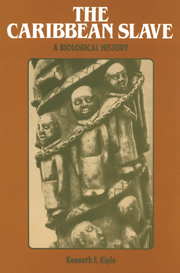Book contents
- Frontmatter
- Contents
- List of Tables
- Preface
- Acknowledgments
- Part I Background and Biology
- Introduction
- 1 The Peoples and Their Pathogens
- 2 West African Diet and Disease
- 3 The Parameters of West African Survival
- Part II Diet, Disease, and Demography
- Part III Pathogens and Politics
- Notes
- Bibliographic Essay
- Index
3 - The Parameters of West African Survival
Published online by Cambridge University Press: 19 October 2009
- Frontmatter
- Contents
- List of Tables
- Preface
- Acknowledgments
- Part I Background and Biology
- Introduction
- 1 The Peoples and Their Pathogens
- 2 West African Diet and Disease
- 3 The Parameters of West African Survival
- Part II Diet, Disease, and Demography
- Part III Pathogens and Politics
- Notes
- Bibliographic Essay
- Index
Summary
It would be foolish to proceed on the assumption of biochemical similarity between widely separated peoples, when archaeology, palaeoanthropology, and history have given us every reason to expect otherwise.
Norman Kretchmer (1977)There are indeed important differences between blacks and whites with respect to the manifestations of disease, and…these differences need to be further documented and investigated so that we might handle them more intelligently.
Richard Allen Williams (1974)If nature gave West Africans the ability to live with malnutrition in a manner that most peoples cannot, then biological evidence of such an ability must exist. This chapter is devoted to exploring the hypothesis that such evidence is extant and may be found in the ways in which the nutritional requirements of West Africans and people of West African ancestry seem to differ from people of European ancestry whose nutritional requirements, at the moment, constitute the world's “standards.”
Iron
We saw in the previous chapter that iron deficiency anemia was widespread among heavily parasitized West Africans. Yet numerous studies have revealed that Americans of West African origin, without heavy parasite loads, also experience a high frequency of iron deficiency anemia – a frequency much higher than that of white Americans. Put more technically, studies on blacks and whites, especially children, have determined that white children have much higher red blood cell volumes and higher hematocrit readings than black children. Moreover, this important difference does not appear to be a function of immediate environmental circumstances as has often been argued (e.g., a less nutritious black diet owing to socioeconomic status), for the condition does not seem to be altered by iron supplementation.
- Type
- Chapter
- Information
- The Caribbean SlaveA Biological History, pp. 38 - 50Publisher: Cambridge University PressPrint publication year: 1985



